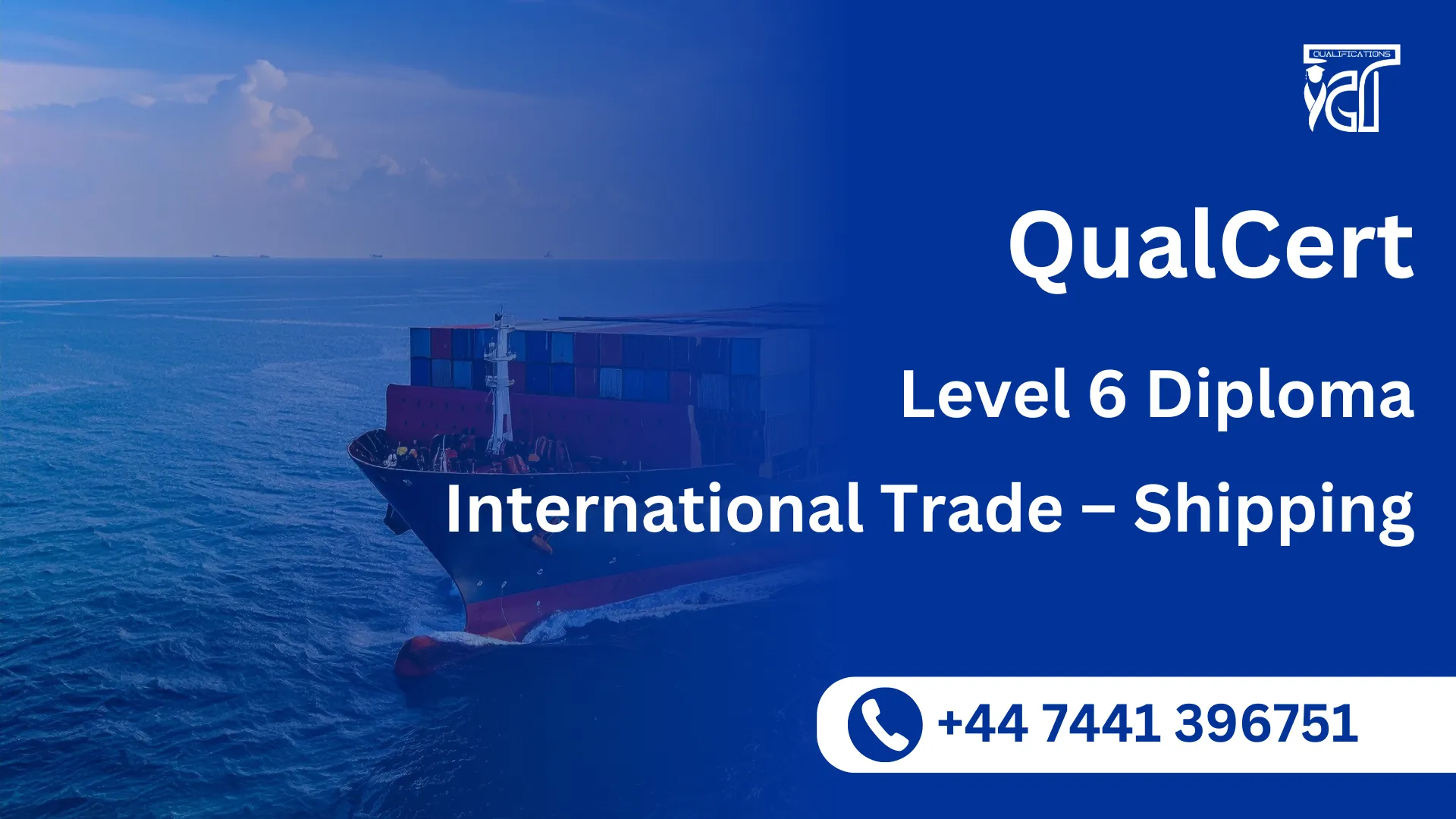The QualCert Level 6 Diploma in International Trade – Shipping is an advanced qualification designed for professionals aiming to progress into senior roles within the global trade and maritime sectors. It equips learners with the strategic knowledge, analytical skills, and practical expertise required to manage complex shipping operations and international trade activities in line with global standards.
This diploma emphasizes the critical role of international trade as the backbone of the world economy and highlights shipping as the primary mode of transporting goods across borders. Learners explore a wide range of advanced topics, including global trade frameworks, shipping logistics, maritime law, international financial regulations, and supply chain integration. The program also addresses risk management, sustainability, and the impact of digital transformation on shipping and trade, ensuring graduates are prepared for the evolving demands of the industry.
By combining theoretical insight with practical application, the course prepares learners to take on leadership, consultancy, and specialist positions in shipping companies, logistics firms, port authorities, and international trade organizations. It also provides a strong foundation for further academic progression into Level 7 Diplomas or postgraduate degrees in logistics, supply chain, or international business.
In short, this diploma is ideal for ambitious professionals who want to become forward-thinking leaders in global trade and shipping, capable of navigating the complexities of international commerce while driving innovation and sustainable practices.
QualCert Level 6 Diploma in International Trade – Shipping
The QualCert Level 6 Diploma in International Trade – Shipping several study units designed to provide learners with a comprehensive understanding of QC principles and practices in the software sector. Below is the qualification structure, including the Total Qualification Time (TQT) 1200, Guided Learning Hours (GLH) 600, and 120 Credits associated with the program.
| Unit Ref# | Unit Title | Credit | GLH | TQT |
| QC06170 – 1 | Strategic Management of International Trade and Shipping | 20 | 100 | 200 |
| QC06170 – 2 | Global Trade Frameworks, Policy and Governance | 20 | 100 | 200 |
| QC06170 – 3 | Advanced Shipping Logistics and Supply Chain Integration | 20 | 100 | 200 |
| QC06170 – 4 | International Trade Finance, Risk and Compliance | 20 | 100 | 200 |
| QC06170 – 5 | Innovation, Technology and Sustainability in Shipping | 20 | 100 | 200 |
| QC06170 – 6 | Research Project in International Trade and Shipping | 20 | 100 | 200 |
GLH (Guided Learning Hours) and TQT (Total Qualification Time) are terms commonly used in vocational qualifications to help define the amount of time a learner is expected to spend on their studies.
1. GLH (Guided Learning Hours)
GLH refers to the number of hours a learner spends being directly taught, supervised, or supported during their course. This includes the time spent in activities such as:
- Classroom instruction
- Practical workshops
- One-on-one tutoring or mentoring sessions
- Online learning sessions with tutor support
In other words, GLH represents the time that learners are actively engaged with their instructors or learning activities.
2. TQT (Total Qualification Time)
TQT represents the total amount of time a learner is expected to invest in completing a qualification, including:
- GLH (Guided Learning Hours): Time spent on direct learning, as explained above.
- Self-Directed Learning: This includes time spent on independent study, research, assignment completion, preparation for exams, and any other work the learner does outside of direct teaching hours.
TQT is a broader measure that includes all the time required to achieve the qualification. It helps learners and employers understand the overall commitment required for the qualification.
Key Differences Between GLH and TQT:
- GLH focuses on direct learning with guidance or supervision.
- TQT includes GLH as well as independent study time and other learning-related activities.
Example:
If a qualification has a TQT of 600 hours and a GLH of 250 hours, it means the learner should spend 250 hours in direct learning (classroom, online, or tutor-led sessions) and 350 hours on independent study or research.
Learning Outcomes:
Strategic Management of International Trade and Shipping
- Analyse the strategic role of shipping in global trade networks.
- Evaluate management approaches for international trade operations.
- Apply leadership principles to shipping and trade scenarios.
- Assess the impact of competition on trade and shipping performance.
- Develop strategies for improving efficiency and profitability.
- Demonstrate knowledge of long-term planning in trade and shipping.
- Critically evaluate case studies of successful trade management.
Global Trade Frameworks, Policy and Governance
- Demonstrate advanced knowledge of international trade frameworks.
- Evaluate the role of WTO, UNCTAD, and other governing bodies.
- Apply governance frameworks to shipping and trade operations.
- Assess compliance requirements for international trade agreements.
- Analyse the impact of trade policies on shipping markets.
- Critically evaluate the effectiveness of global trade governance.
- Develop strategies for ensuring compliance in complex trade environments.
Advanced Shipping Logistics and Supply Chain Integration
- Analyse the role of shipping within global supply chains.
- Evaluate the relationship between shipping lines, ports, and inland logistics.
- Apply advanced knowledge of multimodal transport systems.
- Assess the impact of globalisation on shipping operations.
- Demonstrate understanding of trade facilitation measures.
- Critically evaluate supply chain risks and resilience strategies.
- Develop solutions for integrating shipping into global logistics networks.
International Trade Finance, Risk and Compliance
- Demonstrate advanced knowledge of trade finance instruments.
- Evaluate the role of banks and financial institutions in trade.
- Apply compliance requirements to international trade finance.
- Assess the impact of financial risks on trade operations.
- Analyse the role of anti-money laundering and sanctions frameworks.
- Critically evaluate case studies of trade finance disputes.
- Develop strategies for managing financial risks in trade.
Innovation, Technology and Sustainability in Shipping
- Analyse the role of digitalisation in modern shipping operations.
- Evaluate the impact of automation and smart technologies.
- Apply knowledge of IT systems for cargo tracking and trade efficiency.
- Assess the benefits and challenges of digital transformation.
- Demonstrate understanding of sustainability in shipping and trade.
- Develop strategies for adopting innovative technologies in ports and shipping.
- Critically evaluate global trends in sustainable trade practices.
Research Project in International Trade and Shipping
- Identify a relevant research topic within international trade and shipping.
- Formulate clear research objectives and methodology.
- Conduct independent research using appropriate sources.
- Analyse and interpret trade and shipping data to support findings.
- Apply critical thinking to evaluate research outcomes.
- Present research in a structured and professional format.
- Demonstrate the ability to link research to industry practice.
Course Benefits:
The QualCert Level 6 Diploma in International Trade – Shipping offers advanced knowledge and practical expertise that prepare learners for senior roles in global trade and maritime logistics. It is designed to strengthen both professional careers and academic progression.
1. Advanced Knowledge of International Trade
- Gain a deep understanding of global trade frameworks, shipping logistics, and supply chain integration.
- Learn about international financial regulations, maritime law, and compliance standards.
- Develop expertise in risk management, sustainability, and digital transformation in shipping and trade.
2. Career Advancement Opportunities
- Progress into senior roles such as International Trade Manager, Shipping Director, Port Operations Manager, or Logistics Consultant.
- Enhance employability in multinational corporations, shipping lines, freight forwarding firms, and trade organizations.
- Build credibility as a specialist in international trade and maritime operations.
3. Practical and Strategic Skills
- Strengthen leadership, decision-making, and problem-solving abilities.
- Gain practical insights through case studies, projects, and industry-focused modules.
- Learn to design and implement strategic solutions for complex trade and shipping challenges.
4. Pathway to Higher Education
- Provides progression to Level 7 Diplomas in Strategic Management, Logistics, or International Business.
- Builds a strong academic foundation for doctoral research in trade and maritime studies.
5. Global Recognition and Professional Growth
- Earn an internationally recognized qualification valued by employers worldwide.
- Enhance eligibility for professional memberships in trade and logistics bodies such as the Chartered Institute of Logistics and Transport (CILT).
- Access continuous professional development opportunities in the global shipping and trade sector.
6. Flexibility and Industry Relevance
- Designed for working professionals seeking to balance study with career commitments.
- Offers practical, industry-relevant content aligned with current global trade and shipping practices.
- Equips learners to adapt to emerging trends such as digitalization, sustainability, and global supply chain resilience.
Ideal Learner
The ideal learner for the QualCert Level 6 Diploma in International Trade – Shipping is a professional or graduate who wants to advance into senior roles in global trade, shipping, and logistics. This program is designed for ambitious individuals who already have some academic or industry background and are ready to develop advanced expertise.
- Individuals already working in shipping companies, freight forwarding firms, logistics providers, or port operations.
- Professionals aiming to move into leadership, consultancy, or specialist roles in international trade and maritime logistics.
1. Mid-Career Professionals
- Individuals already working in shipping companies, freight forwarding firms, logistics providers, or port operations.
- Professionals aiming to move into leadership, consultancy, or specialist roles in international trade and maritime logistics.
2. Graduates and Academically Qualified Learners
- Holders of a Level 5 Diploma or a bachelor’s degree in business, logistics, supply chain, or maritime studies.
- Learners who want to specialize further in international trade and shipping management.
3. Career Advancers
- Supervisors or managers in logistics, trade compliance, or shipping operations who want to strengthen their strategic and analytical skills.
- Professionals seeking to enhance their decision-making, leadership, and problem-solving abilities for senior positions.
4. International Trade Enthusiasts
- Learners with a strong interest in global trade frameworks, maritime law, financial regulations, and supply chain integration.
- Individuals motivated to understand the impact of digital transformation and sustainability on shipping and trade.
5. Future Academics and Researchers
- Those considering doctoral research in trade, shipping, or maritime studies.
- Learners completing this program can advance into doctoral-level studies.
Future progression after completing the QualCert Level 6 Diploma in International Trade – Shipping includes both advanced career opportunities and higher academic pathways. This diploma is designed to prepare learners for senior roles while also opening doors to postgraduate study.
1. Career Opportunities
- Senior Management Roles: Positions such as International Trade Manager, Shipping Director, Port Operations Manager, or Global Logistics Consultant.
- Specialist Roles: Opportunities in trade compliance, maritime law, customs management, and international financial operations.
- Global Employment: Work with multinational corporations, shipping lines, freight forwarding firms, port authorities, and international trade organizations.
- Consultancy & Entrepreneurship: Establish independent consultancy services in shipping, logistics, or trade advisory.
2. Progression to Higher Qualifications
- Level 7 Diplomas: Direct pathway to advanced diplomas in Strategic Management, Logistics, or International Business.
3. Professional Development
- Professional Memberships: Enhanced eligibility for memberships in bodies such as the Chartered Institute of Logistics and Transport (CILT) or the Institute of Export & International Trade.
- Industry Certifications: Opportunity to pursue specialized certifications in customs, compliance, or supply chain leadership.
- Global Networking: Access to international trade and shipping networks, strengthening career mobility worldwide.
4. Long-Term Growth
- Leadership Pathways: Progression into executive-level positions such as Director of International Trade or Chief Supply Chain Officer.
- Sector Diversification: Ability to move into related industries such as e-commerce logistics, procurement, or global supply chain strategy.
- Thought Leadership: Opportunities to contribute to policy-making, sustainability initiatives, and digital transformation in global trade.
Entry Requirements
The entry requirements for the QualCert Level 6 Diploma in International Trade – Shipping are designed for professionals and graduates who want to advance into senior roles in global trade and maritime logistics.
- Age: 21 years or older.
- Education: Level 5 Diploma or bachelor’s degree in business, logistics, supply chain, or maritime studies
- Work Experience: 3–5 years of relevant industry experience (supervisory experience preferred).
- English Proficiency: IELTS 6.0 or equivalent for non-native speakers.
- Personal Qualities: Strong interest in international trade, shipping, and logistics, with motivation to progress into leadership roles.
Register Now
Qualification Process
Qualification Process for the QualCert Level 6 Diploma in International Trade – Shipping
- Self-Assessment:
Begin by evaluating your eligibility to ensure you meet the qualification requirements, including work experience, knowledge, and language proficiency. - Registration:
Complete your registration by submitting the required documents, including a scanned copy of a valid ID, and paying the registration fee. - Induction:
An assessor will conduct an induction to confirm your eligibility for the course and explain the evidence requirements. If you do not meet the criteria, your registration will be canceled, and the fee will be refunded. - Assignmnets & Evidence Submission:
Provide all assignmnets and the necessary evidence based on the assessment criteria outlined in the course. If you are unsure of the required evidence, consult with the assessor for guidance on the type and nature of evidence needed. - Feedback and Revision:
The assessor will review your submitted evidence and provide feedback. Evidence that meets the criteria will be marked as “Criteria Met,” while any gaps will be identified. You will be asked to revise and resubmit if needed. - Competence Evidence:
Submit final evidence demonstrating that all learning outcomes have been met. This evidence will be marked as “Criteria Met” by the assessor once it is satisfactory. - Internal Quality Assurance (IQA):
The Internal Quality Assurance Verifier (IQA) will review your evidence to ensure consistency, quality, and compliance with standards. - External Verification:
The IQA will submit your portfolio to QualCert External Quality Assurance Verifiers (EQA) for final confirmation. The EQA may contact you directly to verify the authenticity of your evidence. - Certification:
Upon successful completion of all checks, QualCert will issue your official certificate, confirming that you have attained the QualCert Level 6 Diploma in International Trade – Shipping.







